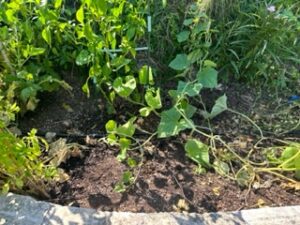
An example of an August garden with cucumbers, poblano peppers, tomatoes, and basil holding on but empty spaces where spaghetti squash and nasturtium succumbed to heat and insects.
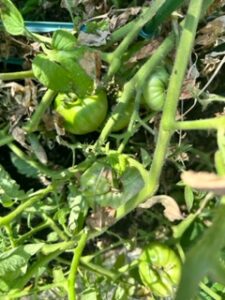
Black Krim tomatoes going strong despite heat, waiting for cooler weather.
Stay Hydrated and Keep the August Vegetable Garden Going – Tips from Paula Wolfel
August is an interesting time for gardeners in Austin. Vegetable gardens consist of plants that have survived or are surviving the heat but have dormant and empty spots from plants that succumbed to high temperatures or pests and diseases.
For those who have tomato, pepper, eggplant, squash, melons, and cucumbers that are still going strong, continue to water daily and to provide a water-soluble fertilizer once a week.
If you’ve got empty spots or those who are ready to start new, clean up the remnants from summer and plan and prep for the milder days that will come. The first frost in Central Texas usually arrives in late November or early December which means you have over 3 months of frost-free weather ahead. Gardeners can concentrate on the array of cool season vegetables that thrives in fall’s cooler temperatures or there is still time for a round two of green beans, cucumbers, squash, and tomatoes, which start producing about two months after sowing seeds.
Things to Do in the August Vegetable Garden
Water and Irrigation
- Water continues to be the most important factor in the garden as the temperatures remain consistently above 90 degrees without rain. Continue to water your plants at the soil line every day if needed and give them a long, deep water once a week.
- Irrigate in the morning. Wilted plants in the afternoon is a natural response. Watering at night in times of high humidity can promote fungal disease.
- Water new seedlings regularly and transplants daily; direct sun combined with high temperatures can be a death sentence for a tender seedling without an established root system.
Fertilizer
- As tomatoes, eggplants, peppers, and squash begin to flower again and form fruit, give them a boost with an application of water-soluble fertilizer according to label directions.
Soil
- Clean up any dead plants.
- In preparation for planting, spread a 2-inch layer of compost over the garden beds and mix it in lightly. Water the area well before planting seeds or transplants.
- Put down a layer of mulch. It is an important component for the vegetable garden. It moderates soil temperatures, deters weeds, helps conserve moisture, and gradually breaks down and enriches soil. Dried grass clippings, leaves, pine straw, partially decomposed compost, and shredded bark are suitable options.
What to Plant in the August Vegetable Garden
- Shade young seedlings and transplants from direct afternoon sun. Use what you have on hand – an old window screen, shade cloth, sheets, cardboards, or umbrellas. It is not permanent and does not have to look pretty but it will give your plants a fighting chance.
- If you have decided to grow cucumbers, squash, or green beans, plant seeds in late August or early September. For best results, choose varieties that mature in less than 60-days and be prepared to water daily until they are established.
- Take into account the milder temperatures and shorter days that will slow the growth of fall plantings.
- Seeds:
- Beets (late month)
- Carrots (late month)
- Corn (early-mid month)
- Greens, warm season (early-mid month)
- Turnips, (late month)
- Transplants:
- Broccoli (late month)
- Brussel sprouts (late month)
- Cabbage (late month)
- Cauliflower (late month)
- Eggplant (early-mid month)
- Okra (early-mid month)
- Peppers (early-mid month)
- Tomatoes (early-mid month)
- Transplants or Seeds:
- Beans, snap and lima (mid to late month)
- Chard, Swiss (late month)
- Collards (late months)
- Cucumber (all month)
- Kohrabi (late month)
- Mustard (late month)
- Peas, southern (early-late month)
- Potato, Irish (mid-late month)
- Squash, summer (all month)
- Squash, winter (early-mid month)
Diseases and/or Pests to Look For in the August Vegetable Garden
- Aphids: a strong spray of water can easily dispatch them from the leaves or remove the leaves and put into a cup of soapy water. The soap breaks down their protective exterior and the aphids become dehydrated and die.
Maintenance
- Pull weeds from the garden. They compete with young plants for water and nutrients.
- Continue to pull up any summer plants that are infested with pest damage or disease. Remember, whatever malady they are suffering from will get worse, not better, during the stress of summer heat.
Harvest
You can harvest any tomato once the green turns to a yellowish-orange and it will ripen on your counter, especially if placed next to bananas or in a brown paper bag. You can harvest green tomatoes and they will ripen-just take a bit longer-or you can use in roasted tomato salsa, fried green tomatoes, or chop and add to a vegetable sauté. Store on counter or in bowl with stem side down to encourage ripening.
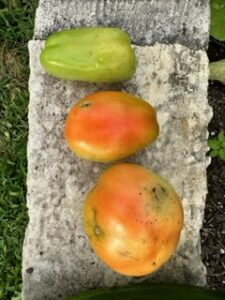
Example of range of color that you can pick your tomatoes.
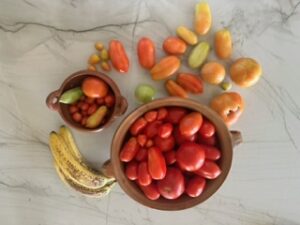
All tomatoes in this photo were picked upon the first sign of yellow/orange and ripened on the counter.
Preparing Your Fall Garden
In preparation for fall, check your seed inventory and peruse seed catalogs for varieties that grow well in Austin and fit Austin’s required “days to harvest.” Popular vegetables for the fall garden include broccoli, Brussel sprouts, cauliflower, cabbage, collards, kale and spinach, beets, radishes, and Swiss chard, as well as bush beans, cucumbers, and summer squash. In choosing frost-tender varieties look for those that will mature in less than 65-days.
You can save money by growing your own transplants of fall crops indoors under grow lights. Start planting seeds of broccoli, cauliflower, cabbage and other falls crops early in the month so they can be transplanted in September.
One habit to start, is to sketch out a garden planning grid and include a rotation plan for growing vegetables. Crops within the same family are often susceptible to the same pests or diseases. If possible, move or rotate plants to different locations to help break the pest/disease cycle.
Keep Up With Tool Maintenance
Find a shady tree or a patio and get caught up on tool maintenance.
Additional Resources
Watch the Vegetable Gardening in Central Texas Webinar
Vegetable Planting Calendar (English) (Español) (繁体中文)
Recommended Vegetable Varieties for Travis County
Plant Rotations, Successions and Intercropping
Monthly Gardening Calendar for Austin and Central Texas
About Paula Wolfel
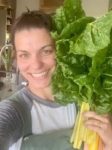 Paula Wolfel joined the Travis County Master Gardener program in 2022, but has been gardening in Austin, Texas since 2017. She grew up in the suburbs of Chicago learning how to garden from both her father—a Sicilian vegetable and fruit tree gardener—and both her grandmothers, and then spent years in Virginia gardening. Paula loves gardening because she finds it to be a grounding force- it gets her out of her head and into the present. She loves the pride that comes with cooking a meal for her family with every ingredient coming from her garden… and then the humility she feels when she loses an entire crop because of Mother Nature. She finds gardening to be wisdom, lessons, best practices passed down generation to generation, season to season and hopes to share that with you.
Paula Wolfel joined the Travis County Master Gardener program in 2022, but has been gardening in Austin, Texas since 2017. She grew up in the suburbs of Chicago learning how to garden from both her father—a Sicilian vegetable and fruit tree gardener—and both her grandmothers, and then spent years in Virginia gardening. Paula loves gardening because she finds it to be a grounding force- it gets her out of her head and into the present. She loves the pride that comes with cooking a meal for her family with every ingredient coming from her garden… and then the humility she feels when she loses an entire crop because of Mother Nature. She finds gardening to be wisdom, lessons, best practices passed down generation to generation, season to season and hopes to share that with you.

